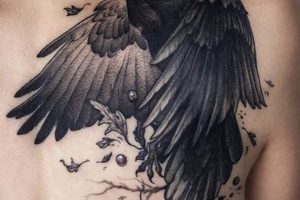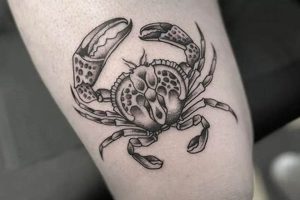Traditional Japanese tattoos, known as Irezumi, represent a rich artistic heritage. Often large-scale and featuring vibrant colors, these designs typically depict mythical creatures, animals, flowers, and historical figures, interwoven with dynamic backgrounds of waves, clouds, or wind. A single piece can tell a story or represent abstract concepts like strength, courage, or good fortune. For example, a koi fish swimming upstream might symbolize perseverance and overcoming adversity.
The significance of Irezumi extends beyond mere aesthetics. Historically, these tattoos could denote social status, spiritual beliefs, or membership in specific groups. Today, they remain powerful expressions of personal identity and appreciation for Japanese art and culture. The meticulous detail and symbolism embedded in each design contribute to the enduring popularity of this tattoo style, attracting individuals seeking meaningful and visually striking body art.
Exploring specific motifs, understanding their cultural context, and considering placement and size are crucial steps in choosing a design that resonates deeply. Further sections will delve into popular themes, the artistic process, and the importance of finding a reputable and skilled artist specializing in this complex tradition.
1. Subject Matter (Imagery)
Imagery forms the core of Japanese tattoo design, imbued with symbolic meaning that transcends mere aesthetics. The chosen subject matter communicates specific narratives, personal values, or aspirations. For example, a dragon symbolizes strength and wisdom, while a phoenix represents rebirth and triumph over adversity. Peonies signify prosperity, and cherry blossoms symbolize the fleeting beauty of life. Understanding the cultural significance of each element is crucial for creating a meaningful and respectful tattoo.
Specific animalistic motifs, like the koi fish ascending a waterfall, embody resilience and overcoming challenges. Mythological creatures, such as the Kirin (a benevolent chimera), represent protection and good fortune. Selecting imagery requires careful consideration of its traditional meaning and resonance with the individual’s personal journey. These symbolic narratives contribute depth and cultural richness to the overall design, differentiating traditional Japanese tattoos from purely decorative body art.
Careful consideration of subject matter ensures the resulting tattoo possesses cultural integrity and personal significance. While artistic freedom allows for contemporary interpretations, respecting established symbolism remains essential. The chosen imagery becomes a powerful statement, communicating a story that resonates both visually and culturally. This understanding elevates the tattoo beyond mere decoration, transforming it into a meaningful and enduring work of art.
2. Composition and Flow
Composition and flow are fundamental principles in Japanese tattooing, dictating how individual elements harmonize to create a cohesive and visually captivating whole. A well-composed tattoo considers the body’s natural contours, using them as a canvas to enhance the design’s movement and impact. This dynamic interplay between subject matter and placement distinguishes traditional Japanese tattoos, creating a sense of balance and visual narrative.
- Body as Canvas:
Japanese tattooing utilizes the body’s curves and musculature as an integral part of the design. The placement of elements like dragons, waves, or flowers follows the natural lines of the body, enhancing the tattoo’s three-dimensional form and creating a sense of movement. This approach transforms the body into a living canvas, showcasing the interplay between art and anatomy.
- Movement and Balance:
Dynamic flow is crucial in Japanese tattoo design. Elements are often depicted in motion, creating a sense of energy and vitality. For example, a dragon might be shown coiling around the arm, or waves crashing against rocks. This dynamic movement is balanced by careful placement and the use of negative space, preventing the design from feeling cluttered or overwhelming.
- Narrative and Symbolism:
The arrangement of elements tells a story or conveys a symbolic meaning. The placement of specific motifs relative to each other can enhance their narrative significance. For instance, a koi fish swimming upstream, juxtaposed with a descending waterfall, emphasizes the struggle and ultimate triumph symbolized by the koi.
- Visual Harmony:
The overall composition aims to create a visually harmonious and balanced aesthetic. The use of color, negative space, and the interplay between different elements contribute to this sense of visual unity. The tattoo should flow seamlessly across the body, creating a cohesive and captivating piece of art.
Masterful composition and flow are hallmarks of traditional Japanese tattoos. These principles, rooted in artistic tradition and a deep understanding of the human form, elevate the tattoo beyond mere decoration, transforming it into a dynamic and meaningful expression of personal narrative and cultural heritage. The skillful integration of these elements distinguishes authentic Japanese tattooing, creating powerful and visually stunning works of art that resonate with both the wearer and the observer.
3. Color Palettes
Color palettes in Japanese tattoos are integral to their aesthetic impact and cultural significance. Specific colors hold symbolic meaning, contributing to the overall narrative of the design. The selection and combination of colors are carefully considered, creating a visual harmony that enhances the imagery and its underlying message.
- Primary Colors:
Traditional Japanese tattoos frequently utilize a core set of primary colors: black, red, and white. Black ink, often derived from natural sources like soot, forms the foundation of the design, outlining figures and creating depth. Red, typically derived from cinnabar, adds vibrancy and represents strength, passion, or protection. White, often used to create highlights and contrast, symbolizes purity, innocence, or the divine.
- Secondary Colors:
Secondary colors like yellow, green, and blue are incorporated to complement the primary palette and add further symbolic depth. Yellow, associated with imperial power and prosperity, might be used for depicting certain flowers or mythical creatures. Green, often used for foliage and natural elements, represents growth and life. Blue, associated with water and the sky, can evoke tranquility or symbolize the vastness of the ocean.
- Color Symbolism:
Beyond their visual impact, colors hold cultural and symbolic meaning in Japanese tattooing. Certain colors are associated with specific deities, animals, or elements, adding layers of interpretation to the design. For example, purple can represent nobility or spirituality, while pink is often used to depict cherry blossoms, symbolizing the transient beauty of life.
- Color Harmony and Contrast:
The arrangement and balance of colors play a crucial role in the overall composition. Artists skillfully employ contrasting colors to create visual interest and highlight specific elements. The interplay between bold colors and subtle shading contributes to the dynamic and visually striking nature of Japanese tattoos. The careful balance of color ensures visual harmony, preventing the design from appearing cluttered or overwhelming.
The color palette of a Japanese tattoo is more than just an aesthetic choice; it’s an integral part of the design’s narrative and cultural significance. The selection and application of color contribute to the overall impact and meaning of the tattoo, enhancing its visual appeal and symbolic depth. Understanding the traditional use and symbolism of color is essential for creating a truly authentic and meaningful Japanese tattoo.
4. Placement on the Body
Placement is a critical consideration in Japanese tattoo design, influencing both the aesthetic impact and the cultural narrative. Traditional placement often adheres to specific conventions, reflecting historical and symbolic associations. The body becomes a canvas, and the tattoo’s placement interacts with the body’s natural contours, enhancing the flow and visual dynamism of the design. This approach requires careful planning, as the placement can affect how the tattoo appears when the body moves.
Historically, certain placements held specific meanings. For example, chest and back pieces, often featuring large-scale designs like dragons or mythical creatures, were associated with strength and protection. Limb placements, such as sleeves or leg tattoos, could depict flowing elements like water or wind, emphasizing movement and flexibility. Placement could also be used to create a cohesive narrative across the body, with interconnected elements flowing seamlessly from one area to another. Modern interpretations often retain these traditional considerations while allowing for individual expression.
Understanding the historical context of placement is essential for creating an authentic and meaningful Japanese tattoo. While contemporary adaptations allow for greater flexibility, respecting traditional conventions demonstrates an appreciation for the art form’s cultural heritage. Effective placement enhances the visual impact of the tattoo, ensuring that the design complements the body’s natural form and contributes to a cohesive and dynamic narrative. This attention to placement elevates Japanese tattooing beyond mere decoration, transforming it into a powerful form of personal expression and cultural storytelling.
5. Artist Selection
Selecting the right artist is paramount when considering a Japanese tattoo. The artist’s skill, experience, and understanding of traditional techniques and symbolism are crucial for achieving an authentic and meaningful result. A deep understanding of Japanese art and culture informs not only the technical execution but also the respectful representation of chosen imagery. Choosing an artist solely based on price or proximity can compromise the integrity of the design and lead to a result that lacks cultural sensitivity and artistic depth.
- Specialization and Experience:
Seek artists specializing in Japanese tattooing. Years of dedicated practice are necessary to master the intricate techniques, line work, and color palettes characteristic of this style. A portfolio showcasing a consistent body of work within the Japanese tradition demonstrates an artist’s commitment and expertise. Reviewing healed tattoos provides insight into the artist’s long-term skill and the quality of their ink application. Experienced artists understand the cultural nuances and symbolism associated with traditional motifs, ensuring respectful and accurate representation.
- Traditional Techniques:
Traditional Japanese tattooing often utilizes a specific hand-tapped method known as “tebori.” This technique involves inserting ink into the skin using a hand-held needle, resulting in a distinct texture and aesthetic. While modern machine methods can achieve similar results, the traditional approach holds cultural significance and is often preferred by those seeking an authentic experience. Inquire about the artist’s preferred methods and their understanding of traditional techniques to ensure alignment with personal preferences and desired aesthetic outcomes.
- Consultation and Design:
A thorough consultation process is essential. A skilled artist will discuss design ideas, cultural significance, and appropriate placement, taking into account the individual’s preferences and body type. They may offer guidance on traditional motifs and their symbolic meaning, helping to refine the design and ensure its cultural relevance. Open communication and a collaborative approach between artist and client are crucial for achieving a meaningful and personalized result that resonates with both artistic vision and cultural sensitivity.
- Hygiene and Safety:
Prioritize artists who adhere to strict hygiene and safety standards. A reputable studio will maintain a clean and sterile environment, utilizing single-use needles and adhering to proper sterilization procedures. Inquire about the studio’s hygiene practices and certifications to ensure a safe and professional experience. A commitment to safety and hygiene demonstrates professionalism and respect for the client’s well-being, reflecting the artist’s commitment to providing a responsible and ethical service.
The selection of a skilled and knowledgeable artist is an investment in the quality, authenticity, and cultural integrity of a Japanese tattoo. The chosen artist becomes a collaborator, guiding the individual through the design process and ensuring a meaningful and enduring result. Careful consideration of an artist’s specialization, technical skill, cultural understanding, and commitment to safety is crucial for a successful and rewarding tattoo experience. Ultimately, the right artist will help bring the individual’s vision to life, creating a powerful and lasting work of art that reflects both personal narrative and cultural heritage.
Tips for Choosing Japanese Tattoo Designs
Selecting a Japanese tattoo design requires careful consideration of various factors, from cultural significance to artistic execution. The following tips offer guidance for navigating the process and ensuring a meaningful and aesthetically pleasing result.
Tip 1: Research Symbolism: Thorough research into the meaning of chosen imagery is crucial. A dragon, for example, can symbolize wisdom and strength, while a cherry blossom represents the transient nature of life. Understanding the symbolism prevents misinterpretations and ensures the design aligns with personal values.
Tip 2: Consider Placement: Placement impacts both aesthetics and cultural meaning. Traditional placements often hold specific significance. Large-scale designs, like dragons or mythical creatures, often adorn the back or chest, while flowing elements like water or wind may suit limbs. Placement should complement the body’s natural contours and enhance the design’s flow.
Tip 3: Prioritize Quality Over Cost: Japanese tattooing is a complex art form requiring specialized skill. Prioritizing quality over cost ensures the chosen artist possesses the necessary expertise and experience. Investing in a skilled artist results in a higher quality, more meaningful tattoo that will stand the test of time.
Tip 4: Plan for Long-Term Commitment: Traditional Japanese tattoos, especially large-scale pieces, often require multiple sessions and significant time investment. Plan accordingly and commit to the process. Rushing the process can compromise the quality and detail of the final result.
Tip 5: Consult with Reputable Artists: Consultations with reputable artists specializing in Japanese tattooing are invaluable. A skilled artist provides guidance on design, placement, and cultural significance, ensuring the final result aligns with personal preferences and respects artistic tradition.
Tip 6: Respect Cultural Significance: Japanese tattoos are steeped in history and tradition. Respecting their cultural significance is essential. Avoid trivializing or appropriating imagery without understanding its meaning. A respectful approach honors the art form and its rich cultural heritage.
Tip 7: Think About Long-Term Aesthetics: Consider how the tattoo will age over time. Traditional Japanese tattoos, with their bold lines and vibrant colors, tend to age well. Discuss long-term care and maintenance with the chosen artist to ensure the tattoo retains its vibrancy and integrity over the years.
Careful consideration of these tips ensures a well-informed decision, resulting in a Japanese tattoo that is both aesthetically striking and culturally meaningful. A thoughtful approach honors the rich tradition of Japanese tattooing while allowing for personal expression.
By understanding the cultural context, artistic principles, and practical considerations involved, individuals can embark on the journey of acquiring a Japanese tattoo with confidence and respect.
Frequently Asked Questions about Japanese Tattoos
This section addresses common inquiries regarding Japanese tattoos, offering concise and informative responses to facilitate informed decision-making.
Question 1: How much do Japanese tattoos typically cost?
Cost depends on size, complexity, artist’s skill level, and geographic location. Large-scale pieces requiring multiple sessions represent a significant investment. Obtaining a detailed quote from a chosen artist after a consultation is recommended.
Question 2: How long does a Japanese tattoo take to complete?
Completion time varies depending on size, detail, and individual pain tolerance. Large, intricate designs often require multiple sessions spaced weeks or months apart to allow for healing. A full back piece or sleeve can take months or even years to complete.
Question 3: Are Japanese tattoos painful?
Pain levels vary depending on individual tolerance, location on the body, and the specific techniques employed. Certain areas, such as ribs or inner arms, tend to be more sensitive. Discussing pain management strategies with the chosen artist can alleviate discomfort during the process.
Question 4: What is the cultural significance of Japanese tattoos?
Historically, Japanese tattoos held various meanings, from spiritual protection to social status indicators. Specific motifs carry symbolic weight, rooted in Japanese folklore, mythology, and cultural traditions. Researching the cultural context of chosen imagery demonstrates respect for the art form.
Question 5: How should a Japanese tattoo be cared for?
Proper aftercare is crucial for healing and longevity. Following the artist’s specific instructions regarding cleaning, moisturizing, and sun protection is essential. Proper aftercare minimizes the risk of infection and ensures the tattoo heals properly, preserving its vibrancy and detail over time.
Question 6: How do I find a reputable Japanese tattoo artist?
Researching artists specializing in Japanese tattooing is crucial. Review portfolios, seek recommendations, and consult with potential artists to assess their experience, technical skill, and cultural understanding. Prioritize artists who demonstrate a deep respect for the art form and prioritize hygiene and safety.
Addressing these common questions provides a foundational understanding of Japanese tattoos. Thorough research, careful planning, and consultation with reputable artists are essential steps in the decision-making process, ensuring a meaningful and enduring result.
Further sections will explore specific design motifs and their cultural significance in greater detail.
Japanese Tattoo Ideas
Exploring Japanese tattoo ideas requires careful consideration of imagery, composition, color palettes, placement, and artist selection. Each element contributes to the overall aesthetic impact and cultural significance of the design. Traditional motifs, drawn from Japanese folklore and nature, carry symbolic weight, imbuing the tattoo with deeper meaning. The composition emphasizes dynamic flow and balance, utilizing the body’s natural contours as a canvas. Color palettes, rooted in traditional pigments and their symbolic associations, enhance the visual narrative. Placement considerations respect historical conventions while allowing for contemporary interpretations. Finally, selecting a skilled artist specializing in Japanese tattooing is paramount for ensuring authenticity, cultural sensitivity, and technical expertise.
Traditional Japanese tattoos represent a powerful intersection of art, culture, and personal expression. The enduring appeal of these designs lies in their rich symbolism, intricate artistry, and ability to convey profound narratives. Choosing a Japanese tattoo is a significant undertaking, requiring thoughtful reflection and a deep appreciation for the art form’s cultural heritage. Ultimately, a well-chosen design, executed by a skilled artist, becomes a powerful and enduring statement of personal identity and cultural appreciation, a testament to the enduring legacy of Japanese tattooing.







